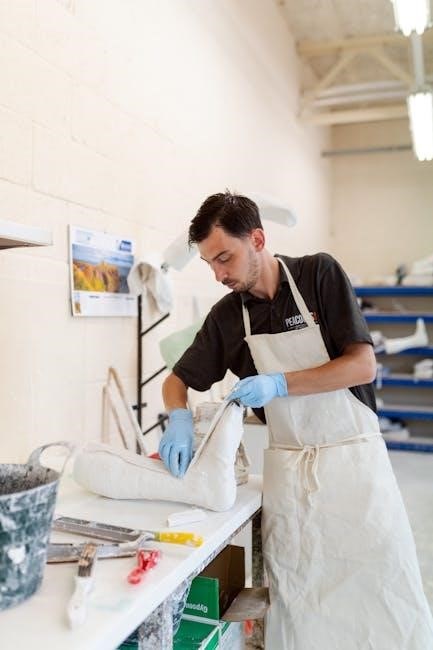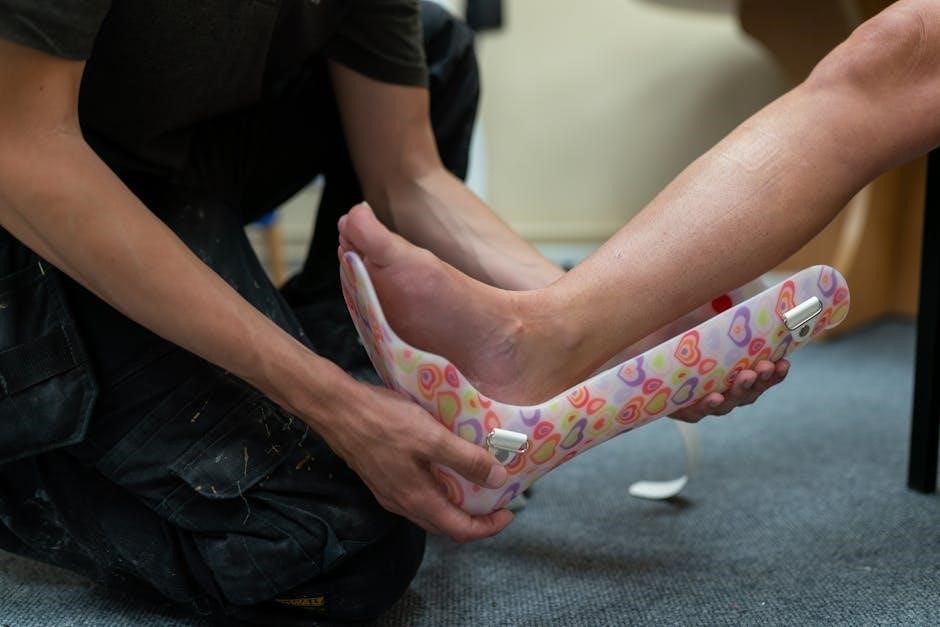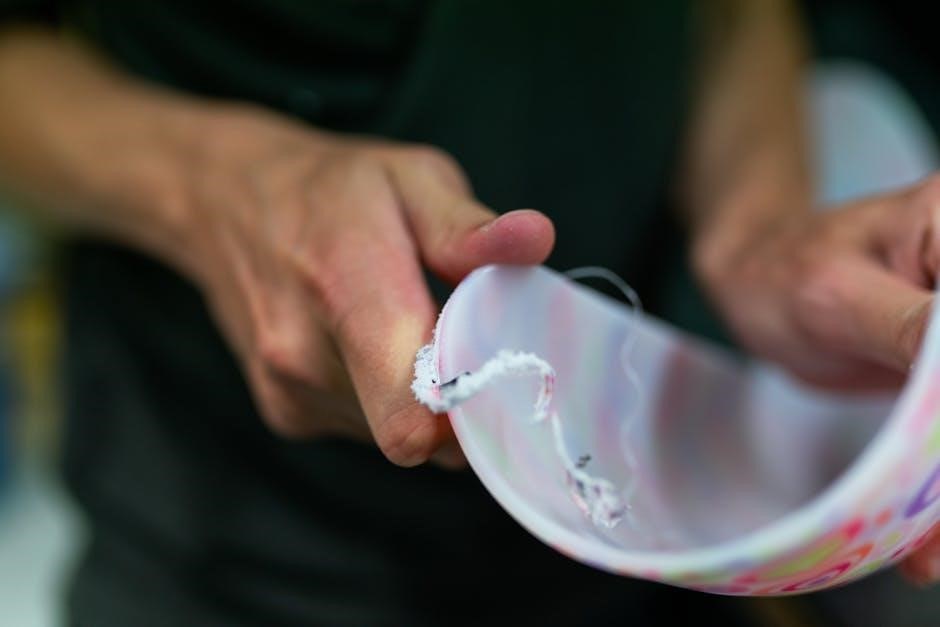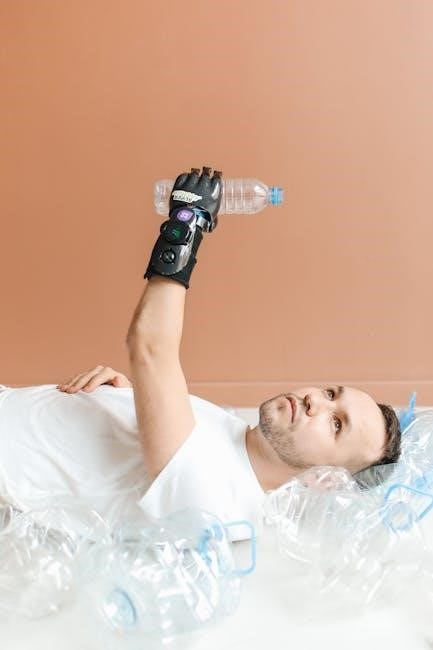The Sarmiento brace is a non-surgical treatment for humeral shaft fractures, providing compression and stability while allowing shoulder and elbow movement. Made from lightweight materials like PP and PVC, it promotes healing and comfort, serving as an effective alternative to surgical intervention.
1.1 Purpose and Benefits
The Sarmiento brace is designed to treat humeral shaft fractures by providing external compression, which stabilizes the bone and promotes healing. Its primary purpose is to immobilize the fracture site while allowing limited movement of the shoulder and elbow, enhancing patient comfort and mobility. The brace is particularly beneficial for patients who require a non-surgical treatment option. It is lightweight and durable, made from materials like PP and PVC, ensuring long-term use without causing discomfort. Additionally, the brace features soft elastic sleeves to prevent skin irritation and improve wearer comfort. Regular adjustments are essential to maintain adequate compression, which is crucial for proper healing and alignment of the bone. This brace is an effective alternative to surgery for many patients.
1.2 Overview of Humeral Shaft Fractures
Humeral shaft fractures occur in the middle portion of the humerus, the long bone of the upper arm. These fractures can result from falls, direct blows, or other traumatic injuries. They are typically classified based on their location, severity, and whether they are open or closed. Symptoms often include pain, swelling, and limited mobility in the affected arm. Treatment options vary depending on the fracture type and patient condition, ranging from non-surgical methods like bracing to surgical interventions. The Sarmiento brace is a popular non-surgical treatment, offering compression to stabilize the fracture while allowing some movement of the shoulder and elbow. This approach is especially beneficial for patients who require a less invasive solution to promote proper healing.

When the Sarmiento Brace is Used
The Sarmiento brace is primarily used for treating humeral shaft fractures, offering a non-surgical solution to stabilize the bone and promote healing through compression.
2.1 Types of Fractures Treated
The Sarmiento brace is specifically designed to treat humeral shaft fractures, which occur in the middle portion of the upper arm bone. It is particularly effective for non-surgical cases where the fracture is stable or minimally displaced. The brace is suitable for both acute and chronic fractures, providing the necessary compression to promote proper healing. It works best when the bone fragments are aligned correctly, either naturally or through minimal manipulation. The Sarmiento brace is not recommended for fractures with significant displacement or instability, as these may require surgical intervention. Its primary function is to stabilize the fracture site while allowing for limited movement of the shoulder and elbow joints. Regular adjustments are necessary to maintain optimal compression and support during the healing process.
2.2 Patient Suitability Criteria
The Sarmiento brace is most suitable for patients with stable, minimally displaced humeral shaft fractures. Ideal candidates are adults with fractures that do not require surgical intervention. Patients must have intact skin and no severe soft tissue injuries. The brace is not recommended for children or adolescents, as their bones are still growing. Additionally, patients with significant obesity or limited mobility may not be good candidates due to fit and compliance challenges. Those with severe comminuted fractures or nerve damage should avoid using the brace. Proper patient selection ensures optimal outcomes, as the brace requires adherence to a structured rehabilitation plan. Consultation with a healthcare professional is essential to determine suitability.

Preparing for the Sarmiento Brace
Preparing involves measuring the arm for proper fit and gathering essential materials like padding, straps, and tools. Consulting a professional ensures accuracy and safety.
3.1 Measuring for the Correct Size
Measuring for the Sarmiento Brace requires precision to ensure a proper fit. The length of the brace is determined by measuring the humerus from the axilla to the olecranon. The circumference of the arm at the mid-humerus level is also measured to ensure the brace fits snugly without causing discomfort. A healthcare professional typically performs these measurements to account for swelling or deformity. The brace must be appropriately sized to accommodate the fracture and promote healing. Proper measurement ensures the brace applies even compression and supports the fracture effectively. Accurate sizing is critical for both comfort and the success of the treatment.
3;2 Essential Materials Needed
The Sarmiento Brace requires specific materials to ensure proper fit and function. These include a lightweight, breathable padding material for comfort, durable straps with adjustable buckles, and a rigid humeral splint to maintain alignment. Additional components may involve a stockinette to cover the arm, providing a snug fit, and side bars or stays for added stability. A measuring tape is essential for accurate sizing. Supplementary items like gel pads can be used to relieve pressure points. All materials are selected to promote healing while minimizing discomfort. Ensuring the brace is made from high-quality, durable materials is crucial for effective treatment and patient satisfaction.

Applying the Sarmiento Brace
Proper application involves positioning the brace correctly, securing it with straps, and ensuring a snug, comfortable fit. Professional guidance is recommended for accurate placement.
4.1 Step-by-Step Application Process
The Sarmiento brace is applied by first ensuring the humerus is properly aligned. Place the brace around the chest and secure it with adjustable straps. Position the upper arm section so it rests comfortably, then wrap the lower section around the forearm. Tighten the straps gradually, starting from the top, to ensure even compression. Check for proper fit by ensuring the brace supports the fracture without causing discomfort. Adjust the padding if necessary to avoid pressure points. Finally, secure all straps firmly and instruct the patient on how to monitor and adjust the brace as needed.
4.2 Ensuring Proper Fit and Comfort
Proper fit is crucial for effective healing and patient comfort. After applying the brace, check that it aligns with the fracture site and does not cause pressure points. Ensure the brace is snug but not overly tight, as this can restrict circulation or cause skin irritation. Adjust the straps evenly, starting from the top, to maintain uniform compression. The patient should be able to move their elbow slightly without discomfort. Regularly inspect the brace for proper alignment and tighten loosened straps as needed. If discomfort or swelling occurs, re-evaluate the fit and make necessary adjustments. Proper fit ensures optimal support and promotes healing.

Adjusting the Brace
Regularly check the brace’s alignment and fit, ensuring it remains snug without causing discomfort. Adjustments should be made to accommodate healing progress and patient comfort.
5.1 How to Tighten the Brace
- Locate the adjustable straps or screws on the Sarmiento brace, typically found at the sides or back.
- Using the provided wrench or tool, gently turn the screws clockwise to tighten the brace.
- Ensure even pressure distribution by tightening both sides equally to avoid uneven compression.
- Check the fit by moving the arm slightly; it should feel secure but not overly restrictive.
- Avoid overtightening, as this can impede blood flow or cause discomfort.
Proper tightening ensures optimal support and alignment for fracture healing.
5.2 Frequency of Adjustments
The Sarmiento brace may require adjustments to maintain proper fit and support during the healing process. Initially, adjustments are made 1–2 days after application to accommodate swelling reduction. Thereafter, adjustments are typically needed every 7–10 days or as discomfort arises. Patients should monitor for signs of swelling or tightness, which may indicate the need for loosening. Conversely, if the brace feels too loose, tightening may be necessary. Regular follow-ups with a healthcare provider are crucial to ensure the brace remains effective and comfortable. Adjustments should only be made under professional guidance to avoid compromising fracture alignment or healing progress.

Wearing the Brace
The Sarmiento brace is worn continuously during the healing process, typically for several weeks or months. Proper wear ensures consistent support and alignment of the fracture.
6.1 Daily Wear and Comfort Tips
Wear the Sarmiento brace daily as directed by your healthcare provider. Ensure the brace is snug but not overly tight to avoid discomfort or skin irritation. Choose breathable, non-irritating clothing to wear under the brace. Regularly inspect the brace for proper fit and adjust straps as needed to maintain support. Avoid excessive movement or bending that could shift the brace out of position. If discomfort arises, consider padding the areas where the brace contacts the skin. Maintain good hygiene by cleaning the brace and your skin daily to prevent odor and infection. Monitor your skin for signs of irritation or redness and address any issues promptly.
6.2 Hygiene and Skin Care
Proper hygiene and skin care are essential when wearing a Sarmiento brace. Clean the brace daily using mild soap and lukewarm water, ensuring it dries thoroughly to prevent bacterial growth. Avoid submerging the brace in water. Gently wash the skin under the brace with a mild cleanser, paying attention to areas prone to sweating. Inspect your skin regularly for redness, irritation, or rashes. If irritation occurs, consider using a hypoallergenic lotion or powder. Wash the brace’s padding periodically to maintain cleanliness. Avoid using harsh chemicals or abrasive cleaners, as they may damage the brace materials. Good hygiene practices help prevent infections and ensure comfort while wearing the brace.
6.3 Monitoring for Skin Irritation
Regularly monitor your skin for signs of irritation while wearing the Sarmiento brace. Check for redness, swelling, or rashes, especially around the edges or straps. Pay attention to areas where the brace applies pressure. If you notice persistent discomfort or skin breakdown, loosen the brace slightly or reposition it. Avoid overtightening, as this can exacerbate irritation. Use soft, breathable clothing under the brace to reduce friction. If irritation persists, consider using padding or cushions on pressure points. Monitor daily and adjust as needed to prevent complications. Seek medical advice if irritation worsens or doesn’t improve with adjustments.

Activities with the Brace
While wearing the Sarmiento brace, avoid heavy lifting, bending, or twisting to prevent reinjury. Stick to low-impact activities like walking or swimming to support recovery safely.
7.1 Permitted Activities
While wearing the Sarmiento brace, patients can engage in light, low-impact activities to maintain mobility and strength without risking further injury. Gentle exercises like seated arm lifts, wrist rotations, and elbow bends are encouraged to prevent stiffness. Walking, swimming, and cycling are also permitted, as they promote healing without excessive strain on the fracture site. However, these activities should be performed under medical guidance to ensure they align with the fracture’s healing progress. Avoid any movements that cause pain or discomfort, as this may indicate improper alignment or overexertion. Always prioritize activities that support recovery while maintaining brace integrity and comfort.
7.2 Activities to Avoid
While wearing the Sarmiento brace, it is crucial to avoid activities that may disrupt the healing process or compromise the fracture. Heavy lifting, bending, or twisting should be avoided, as these can strain the humerus and delay recovery. Contact sports, high-impact exercises, and activities that involve direct stress on the arm should also be avoided. Patients should refrain from placing weight on the affected arm or engaging in movements that cause pain or discomfort. Additionally, activities that involve repetitive arm motions, such as throwing or overhead reaching, should be avoided until cleared by a healthcare provider. Always prioritize rest and stability to ensure proper healing and alignment of the fracture.

Managing Common Issues
Managing Common Issues with a Sarmiento Brace involves addressing swelling, tightness, and skin irritation. Elevate the arm, apply ice, and ensure proper fit to promote healing and comfort.
8.1 Addressing Swelling
Swelling is common after a humeral fracture and can persist while wearing the Sarmiento Brace. To reduce swelling, elevate the arm above heart level whenever possible. Apply ice packs wrapped in a towel to the affected area for 15–20 minutes, several times a day. Ensure the brace fits properly to avoid restricting blood flow, as tightness can worsen swelling. Monitor for excessive swelling, redness, or pain, as these may indicate complications. If swelling persists or worsens, consult your healthcare provider for guidance. They may recommend additional treatments or adjustments to the brace. Always follow their advice to promote healing and comfort.
8.2 Dealing with Tightness
If the Sarmiento Brace feels too tight, it may cause discomfort or restrict blood flow. Check the straps and ensure they are not overly tightened. Loosen the straps slightly if tightness occurs, but avoid over-loosening, as this may reduce the brace’s effectiveness. If tightness persists, consult your healthcare provider to assess the fit and make necessary adjustments. Avoid tightening the brace excessively, as this can lead to numbness, tingling, or impaired circulation. Proper fit is crucial for both comfort and healing. Regular follow-ups with your provider can help address any fit-related issues promptly. Always prioritize comfort while maintaining the brace’s supportive function.
8.3 When to Seek Help
If you experience severe pain, numbness, or tingling while wearing the Sarmiento Brace, seek medical help immediately. These symptoms may indicate nerve compression or improper fit. If swelling increases or persists despite elevation and ice, consult your healthcare provider. Open wounds, redness, or signs of infection around the brace or fracture site require urgent attention. If the brace feels too tight and cannot be adjusted comfortably, or if you notice improper alignment of the arm, contact your doctor. Additionally, if you suspect the fracture is not healing properly or if you have concerns about the brace’s fit or function, schedule a follow-up appointment promptly. Early intervention is key to avoiding complications.

How the Sarmiento Brace Works
The Sarmiento Brace immobilizes humeral shaft fractures, promoting proper alignment and healing. It applies compression to stabilize the fracture site, reducing movement and supporting the bone during recovery.
9.1 Mechanism of Compression
The Sarmiento Brace applies compression through adjustable straps and a rigid splint, ensuring stability for humeral shaft fractures. This compression minimizes bone fragment movement, promoting proper alignment and healing by maintaining consistent pressure. The brace is designed to fit securely around the arm, with materials that allow for even distribution of pressure. It is typically fitted to each patient’s specific measurements to ensure comfort and effectiveness without impeding circulation. The compression can be adjusted as needed, providing continuous support that facilitates the natural healing process of the bone.
9.2 Role in Fracture Healing
The Sarmiento Brace plays a crucial role in fracture healing by immobilizing the fracture site, ensuring proper alignment of bone fragments. This immobilization reduces pain and prevents further injury, creating an optimal environment for healing. Designed specifically for humeral shaft fractures, the brace allows for controlled movement, preventing stiffness while safeguarding the fracture. Proper fit is essential to facilitate healing, and regular follow-ups with healthcare professionals are necessary to monitor progress. Adherence to the provided instructions ensures the brace functions effectively, promoting efficient and proper healing of the fracture.
9.3 Materials Used
The Sarmiento Brace is constructed from lightweight, durable materials designed for comfort and support. The primary components include a plastic or polyethylene shell that encases the arm, providing structural stability. Soft padding lines the interior to enhance comfort and reduce pressure points. Adjustable straps and Velcro closures ensure a secure and customizable fit. The materials are breathable to prevent moisture buildup, promoting skin health. The brace’s design allows for easy cleaning and maintenance, ensuring hygiene. These materials work together to immobilize the fracture effectively while minimizing discomfort, making the Sarmiento Brace a practical solution for managing humeral shaft fractures during the healing process.

Follow-Up Care
Regular medical check-ups ensure proper healing and address any concerns. Monitoring progress helps adjust treatment plans and verify the brace’s effectiveness in supporting recovery.
10.1 Importance of Regular Check-Ups
Regular check-ups with your healthcare provider are crucial to ensure the Sarmiento brace is functioning effectively and safely. These visits allow your doctor to assess the brace’s fit,
check for proper alignment, and monitor the healing progress of your fracture. Regular appointments also help identify and address any potential issues early,
such as skin irritation or improper compression, which could delay recovery. Additionally, check-ups provide an opportunity to adjust the brace as needed and
answer any questions or concerns you may have. Consistent follow-up care is essential to achieve optimal outcomes and ensure a smooth recovery process.
10.2 Monitoring Healing Progress
Monitoring the healing progress of your fracture while using the Sarmiento brace is essential to ensure proper recovery. Your healthcare provider will typically use imaging studies, such as X-rays or CT scans, to assess bone alignment and healing. Regular follow-ups allow your doctor to track the fracture’s progress and make any necessary adjustments to your treatment plan. It’s important to report any changes in symptoms, such as increased pain or limited mobility, as these could indicate issues with the healing process. Monitoring also helps confirm that the brace is providing the necessary support and compression for optimal recovery. Consistent oversight ensures a successful outcome.
The Sarmiento brace is a highly effective treatment for humeral shaft fractures, promoting proper healing and mobility when used correctly. Adherence to instructions ensures optimal recovery.
11.1 Key Takeaways
The Sarmiento brace is a non-invasive, effective treatment for humeral shaft fractures, offering stability and promoting natural healing. Proper application, regular adjustments, and adherence to wearing guidelines are crucial for optimal results. Patients should avoid activities that strain the arm and prioritize hygiene to prevent skin irritation. Monitoring for swelling and tightness ensures comfort and proper fit. Materials like plaster and padding provide support while allowing some movement. Follow-up appointments are essential to track healing progress and address any concerns. By following these instructions, patients can achieve a successful recovery and regain arm functionality.
11.2 Importance of Adherence
Adhering to Sarmiento brace instructions is critical for effective fracture management and proper healing. Non-compliance can lead to delayed recovery, improper alignment, or recurring injury. Consistent wear and correct adjustments ensure the brace applies even pressure, promoting stable healing. Skipping follow-ups or ignoring care guidelines may result in suboptimal outcomes. Patients must prioritize adherence to avoid complications and achieve the best results. Proper use enhances comfort and functionality, enabling a faster return to daily activities. Adherence demonstrates commitment to recovery, ensuring the brace performs as intended and supports overall well-being.


